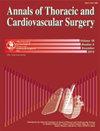急性纵隔炎——外科治疗的结果和预后因素(单中心经验)
IF 1.3
4区 医学
Q4 CARDIAC & CARDIOVASCULAR SYSTEMS
引用次数: 1
摘要
目的:这项工作的目的是对一组在作者工作场所接受治疗的急性纵隔炎患者进行为期15年的回顾性分析,并确定显著影响治疗结果的因素。方法:在2006年至2020年期间,对80例急性纵隔炎患者进行了治疗。在队列中,观察到以下内容:急性纵隔炎的病因和类型、记忆时间、合并症、诊断方法、从诊断到手术的时间、手术程序的类型和次数、微生物检测结果、并发症和治疗结果。结果:急性纵隔炎最常见的类型是降纵隔炎(48.75%),共进行了116次手术。队列中有10名患者死亡(12.5%)。60岁以上的患者死亡风险高出6.8倍。患有两种以上合并症的患者的死亡风险高出14.3倍。培养材料中酵母的存在使死亡风险增加了4.4倍。结论:早期诊断、排除纵隔炎的病因、充分的纵隔清创术、多次引流及术后持续灌洗是成功治疗急性纵隔炎的关键。本文章由计算机程序翻译,如有差异,请以英文原文为准。
Acute Mediastinitis – Outcomes and Prognostic Factors of Surgical Therapy (A Single-Center Experience)
Purpose: The aims of this work were the retrospective analysis of a cohort of patients with acute mediastinitis treated at the authors’ worksite over a 15-year period and the identification of factors that significantly affect the outcomes of the therapy. Methods: During the period 2006–2020, 80 patients with acute mediastinitis were treated. Within the cohort, the following were observed: the causes and the type of acute mediastinitis, length of anamnesis, comorbidities, diagnostic methods, time from the diagnosis to surgery, types and number of surgical procedures, results of microbiological tests, complications, and outcomes of the treatment. Results: The most common type of acute mediastinitis was descending mediastinitis (48.75%). A total of 116 surgical procedures were performed. Ten patients in the cohort died (12.5%). Patients older than 60 years were at a 6.8 times higher risk of death. Patients with more than two comorbidities were at a 14.3 times higher risk of death. The presence of yeasts in the culture material increased the risk of death by 4.4 times. Conclusion: Early diagnosis, removal of the cause of mediastinitis, sufficient mediastinal debridement, and multiple drainage thereof with the possibility of continual postoperative lavage are essential for the successful treatment of acute mediastinitis.
求助全文
通过发布文献求助,成功后即可免费获取论文全文。
去求助
来源期刊

Annals of Thoracic and Cardiovascular Surgery
CARDIAC & CARDIOVASCULAR SYSTEMS-SURGERY
CiteScore
2.80
自引率
0.00%
发文量
56
审稿时长
4-8 weeks
期刊介绍:
Information not localized
 求助内容:
求助内容: 应助结果提醒方式:
应助结果提醒方式:


